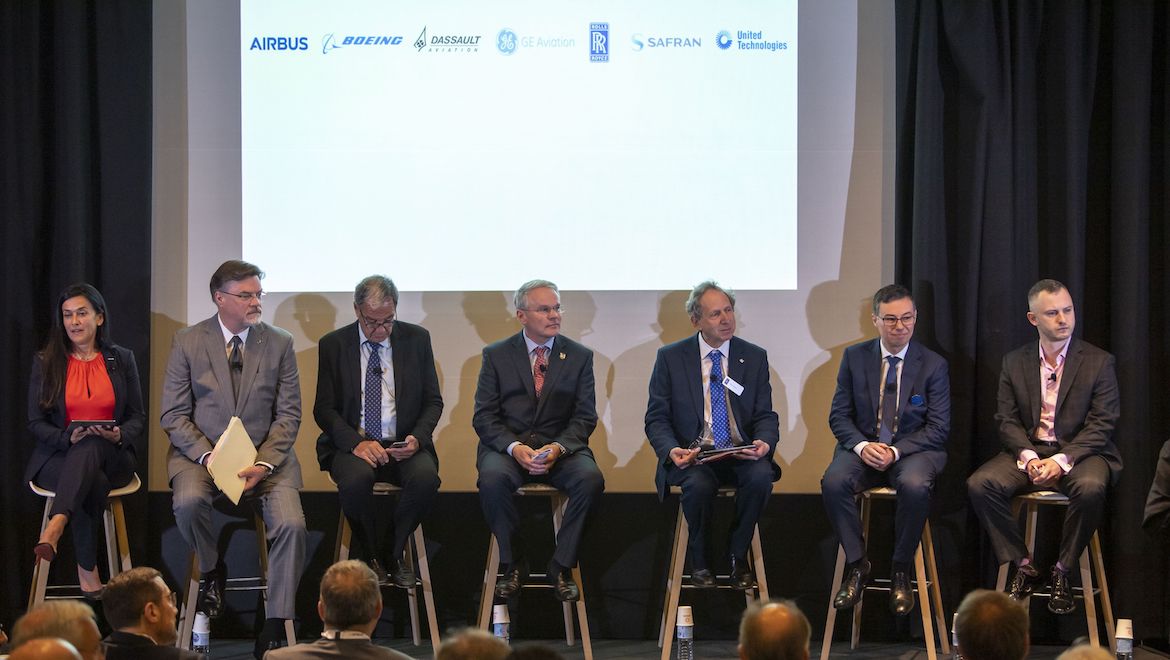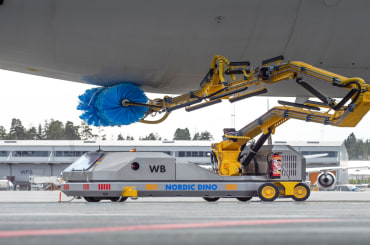
Seven chief technology officers from the world’s biggest largest aerospace manufacturers — Airbus, Boeing, Dassault, GE, Rolls-Royce, Safran and UTC — came together on the second day of the Paris Air Show to set out the industry’s stall on what it is doing and needs to do to regarding sustainability and reduce its environmental impact.
The statement, signed by Airbus’ Grazia Vittadini, Boeing’s Greg Hyslop, Dassault’s Bruno Stoufflet, GE’s Eric Ducharme, Rolls-Royce’s Paul Stein, Safran’s Stéphane Cueille, and UTC’s Paul Eremenko, comes in the face of growing concern over the contribution to climate change from aviation, as well as its wider ecological footprint.
“Aviation connects our world by efficiently and rapidly moving people, opening new economic opportunities and transporting food and goods all over our planet,” the chief technology officers said.
“Aviation promotes global understanding, generating rich cultural exchanges and thereby contributing to peaceful co-existence.
“At the same time, climate change has become a clear concern for our society. Humanity’s impact on the climate requires action on many fronts. The aviation industry is already taking significant action to protect the planet and will continue to do so.
Further, the seven chief technology officers noted aviation contributed to two per cent of human-made carbon dioxide emissions.
It could be said this could perhaps be read as overly minimising the effect of aviation on our changing climate. Carbon dioxide is not the only contributor to climate change, and other high-altitude emissions like oxides of nitrogen or water vapour are widely accepted to contribute more to climate change than similar emissions at ground level. The true impact is often cited as between two to ten per cent of the total.
“The industry has challenged itself to reduce net CO2 emissions even while demand for air travel and transport grows significantly,” the statement said.
“Through the Air Transport Action Group, the aviation industry became the world’s first industrial sector to set an ambitious target: reduce CO2 emissions to half of year 2005 levels by 2050, and to limit the growth of net CO2 emissions by 2020.”
The seven chief technology officers said the industry was expected to meet the near-term commitments, including 2019’s Carbon Offsetting and Reduction Scheme for International Aviation (CORSIA), agreed by the member states of the UN-affiliated international body ICAO, the International Civil Aviation Organisation.
The industry’s future strategy consisted of three primary pillars, made up of incremental improvements and future technology step-changes.
The second pillar was commercialising sustainable alternate aviation fuels, with the latest data suggesting that “around 185,000 commercial flights have already proven that today’s aircraft are ready to use them”.
Third, the industry must develop “radically new aircraft and propulsion technology”, while also boosting the technologies that will lead aviation into its “third age”, after the pre-jet age and the jet age.
They also noted air traffic management and better, more efficient routing would assist, though there was no mention of other factors, including impacts from ground emissions, infrastructure or waste.
“For the last 40 years, aircraft and engine technology has reduced CO2 emissions by a yearly average of over one percent per passenger mile. This has been the result of significant R&D investments in materials, aerodynamic efficiency, digital design and manufacturing methods, turbomachinery developments and aircraft systems optimisation,” the statement said.
Targets will also be important: “For many years, through a variety of industry organizations and international bodies, the aviation community has voluntarily committed to meet a set of aggressive targets for enhanced airplane environmental performance”.
“Targets set by the Advisory Council for Aeronautics Research in Europe call for a 75 per cent reduction in CO2, a 90 per cent drop in NOX and a 65 per cent decrease in noise by 2050, compared with year 2000 levels. To help achieve these aggressive goals, global agreements reached through ICAO call for a fuel-efficiency performance standard to be part of the certification process applied to every airplane.”
But while the companies reaffirmed their commitment to improving the designs of airframes and the engines that power them to improve efficiency, they also highlighted that there were substantial technical challenges and a need for “third generation” changes beyond the incremental.
Fuels were a big part of the picture, and the seven chief technology officers make it clear that aviation would continue to rely on liquid fuels as the fundamental energy source for larger and longer-range aircraft for the foreseeable future.
“Even under the most optimistic forecasts for electric-powered flight, regional and single-aisle commercial airplanes will remain operating in the global fleet with jet fuel for decades to come,” the statement said.
The statement outlined five “pathways” sustainable aviation fuels, which still generate emissions but have lower overall impacts than fossil fuels, have already been approved. Further, commercialisation had begun for one of them.
“We believe that accelerating production scale-up of all commercially viable pathways, while simultaneously developing additional lower cost pathways, is the key to success,” the statement said.
“This work is already underway at research institutions and within companies in various industrial sectors. What is needed is an expansion of government support for technology development, production facility investment, and fuel production incentives around the world.
The “third age” of aviation involved “advances in new architectures, advanced engine thermodynamic efficiencies, electric and hybrid-electric propulsion, digitisation, artificial intelligence, materials and manufacturing”.
“Larger aircraft will begin to benefit from novel designs that will further improve efficiency through management of aircraft drag and distributing propulsion in new ways. New materials will enable lighter aircraft, further improving efficiency,” the statement said.
On top of the industry’s own efforts, this will mean “the coordinated support from policymakers, regulators and governments working together to achieve these goals”, as well as “additional public and private commitment to establish a sound regulatory foundation to address the novel issues associated with emerging aviation technologies and to provide the necessary economic support for widespread sustainable aviation fuel commercialisation”.
The seven companies calld for coordination through the UN-affiliated ICAO — with interestingly no mention of airline trade body the International Air Transport Association — and by national regulators and standard-setters.
The seven companies diverge in their approaches to this third age, but their representatives say that they were “driven by the certainty of its contribution to the role of aviation in a sustainable future”.
“We believe aviation is entering its most exciting era since the dawn of the Jet Age. This third era promises a transformative positive impact on lives around the globe — and we stand ready to make it a reality,” the statement said.












